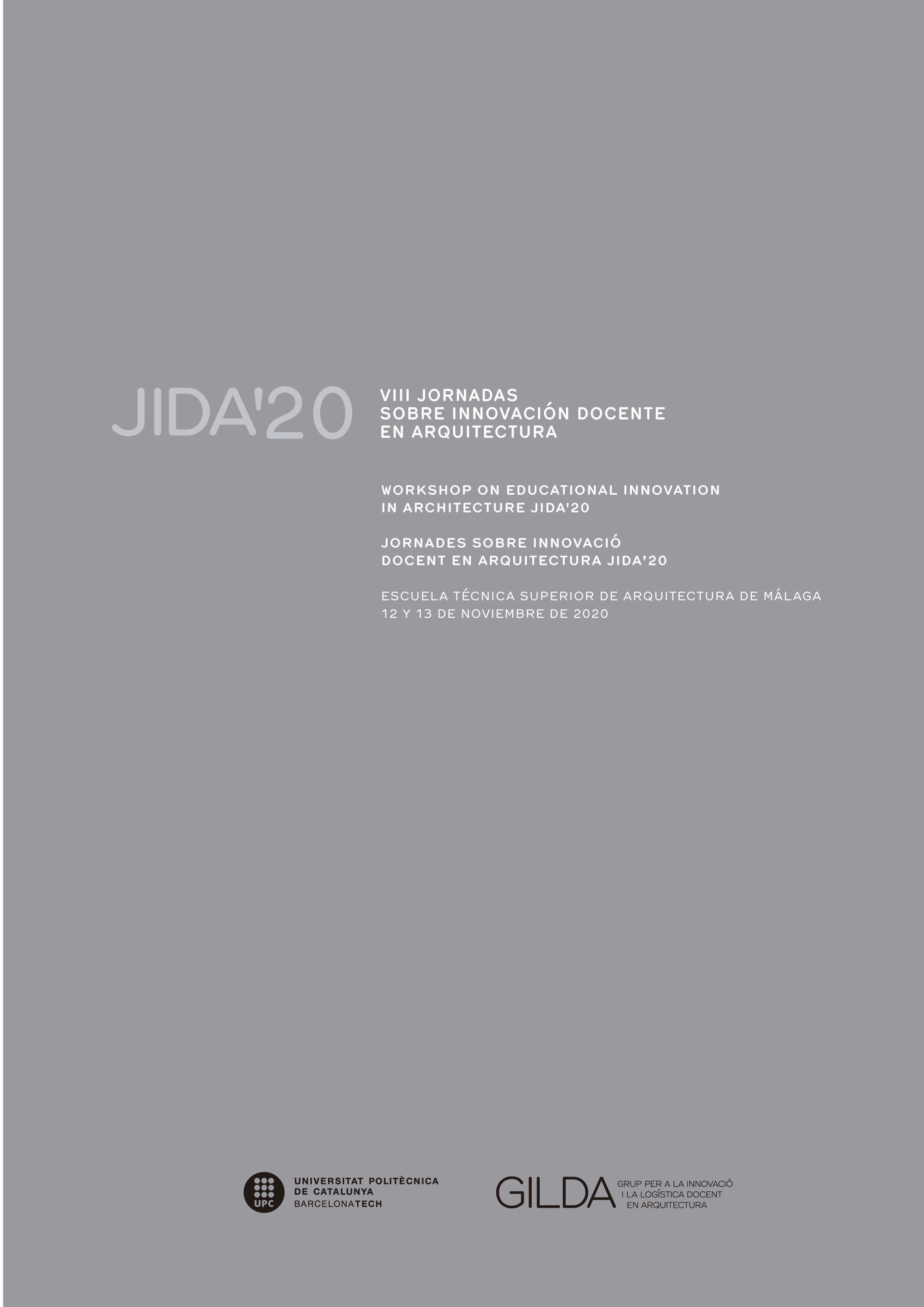Real or Virtual Model as an Integrative Design Studio Tool
DOI:
https://doi.org/10.5821/jida.2020.9409Abstract
The main objective of this paper is determining the pedagogical utility of the architectural model in two possible formats, physical and virtual, having as a field of study the Taller Integrado de Proyectos (hereinafter, TIP) of the fifth year of the School of Architecture of the University of Navarra, and under the experience of the recent confinement due to the global COVID-19 pandemia. The weaknesses and strengths of both formats are differentiated and analyzed depending on the time of the project's temporal development, the availability of means, the nature of the TIP, the group or individual work and the adaptation of the teaching to remote modes, as well as its applicability in relation to the technical subjects that define the project. To prepare this paper, a survey has been drawn up and sent to professors from other national and international Schools of Architecture, who have also been invited to the TIP on some occasion. Questions and results, as well as comments by the 32 definitive participants, are included as an appendix.
References
CARAZO, E. y GALVÃN DESVAUX, G. (2014). “Aprendiendo con maquetas. Pequeñas maquetas para el análisis de arquitectura†en Revista EGA. N.24. 62-71.
FERNÃNDEZ ZAPATA, C.; FREDRIANI SARFATI, A.; SARDÀ FERRAN, J. y SOLANS IBÃÑEZ, I. (2019). “La maqueta en el desarrollo del proyecto†en JIDA Textos de arquitectura, docencia e investigación. N.6. Barcelona: Iniciativa Digital Politécnica. RU Books. 95-113.
FERRUSES, J.; ÃBALOS RAMOS, A.; DÃAZ SEGURA, A. y ROS CAMPOS, A. (2018). “40 asignaturas, 10 destinos, 5 años y una herramienta compartida: viajar†en JIDA: Textos de arquitectura, docencia e investigación. N.5. Barcelona: Iniciativa Digital Politécnica. RU Books. 263-279.
GARNICA, J. y ESPARZA, V. (2006). “Entrevista a Fernando Ãlvarez. Maqueta y aprendizaje†en Revista DC Papers. N. 15-16. 64-71.
GONSÃLEZ, L. y BERTAZZONI, L. (2008). Maquetas la representación del espacio en el proyecto arquitectónico. Barcelona: Gustavo Gili.
GÜL, L.; GU, N. y WILLIAMS, A. (2008) “Virtual Worlds as a Constructivist Learning Platform: Evaluations of 3D Virtual Worlds on Design Teaching and Learning†en ITcon. Vol. 13, 578-593.
HOLTROP, A.; PRINCEN, B.; TEERDS, H.; FLORIS, J., y DE KONING, K. (2011). “Editorial. Models. The Idea, the Representation and the Visionary. Models†en OASE. Vol.84, 20–23. <https://oasejournal.nl/en/Issues/84/Editorial>
HUBERT, C. (2011). “The Ruins of Representation Revisited. Models†en OASE. Vol.84, 11–16 <https://www.oasejournal.nl/en/Issues/84/TheRuinsOfRepresentationRevisited>
MARTÃN-GÓMEZ, C.; IBAÑEZ-PUY, E. y ZUAZUA-ROS, A. (2018). “Heat Kit: Creación de un prototipo para `tocar Ì el calor†en Actas Congreso In-Red 2018. Valencia: Universitat Politècnica de València
<http://dx.doi.org/10.4995/INRED2018.2018.8591>
MASDEU BERNAT, M. (2016). ¨La práctica profesional del arquitecto y su formación en la sociedad actual†en JIDA: Textos de arquitectura, docencia e investigación. N.3. Barcelona: Universitat Politécnica de Barcelona. 244-259.
OECHSLIN, W. (2013) “Manus et intellectus†en Domus. N.972. Milán: Casa ed. Domus. 1928, 12-15.
PALLASMAA, J. (2011). La mano que piensa: sabidurÃa existencial y corporal en la arquitectura. Barcelona: Gustavo Gili.
REDONOD, E; FONSECA, D; SÃNCHEZ, A. y NAVARRO, I. (2013) “New Strategies Using Handheld Augmented Reality and Mobile Learning-teaching Methodologies, in Architecture and Building Engineering degrees†en Procedia Computer Science. 25 ( 2013 ) 52-61
REFFAT, R. (2005). “Collaborative digital Architectural Design Learning within 3D Virtual modelâ€, en The 10th International Conference on Computer Aided Architectural Design Research in Asia, 169-177. <http://cumincad.scix.net/data/works/att/caadria2005_a_1b_a.content.pdf>
RIBOT MANZANO, A.; ESPINOSA PÉREZ, E.; DE ABAJO CASTRILLO, B., y ALTUNA CHARTERINA, G. (2018). “Técnicas proyectuales colaborativas†en JIDA: Textos de arquitectura, docencia e investigación. N.5. Barcelona: Iniciativa Digital Politécnica. RU Books. 82-99.
VAL FIEL, M. (2016). “La maqueta conceptual en la arquitectura paramétrica: la materialidad digital como icono†en Revista Proyecto Progreso y Arquitectura N.15.. Sevilla: Editorial Universidad de Sevilla. 138-150.
YAN, W.; CULP, C. y GRAF, R. (2011). “Integrating BIM and gaming for real-time interactive architectural visualization†en Automatization in Construction. 20. 446-458.






















